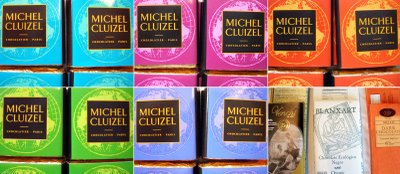chocolate tasting
 There is a lot that sucks about getting older. You gain weight easier, you start forgetting little things and your body doesn’t bounce back from abuse the way it once did. A nice thing about advancing age, though, is that your friends have better birthday celebrations. Take Oliver’s party last night as an example. They hosted and Daphne prepared fantastic butternut squash ravioli with sage butter sauce and served this with cocoa and cinnamon rubbed pork tenderloin that was fabulous. And, to start the night off, they conducted a chocolate tasting.
There is a lot that sucks about getting older. You gain weight easier, you start forgetting little things and your body doesn’t bounce back from abuse the way it once did. A nice thing about advancing age, though, is that your friends have better birthday celebrations. Take Oliver’s party last night as an example. They hosted and Daphne prepared fantastic butternut squash ravioli with sage butter sauce and served this with cocoa and cinnamon rubbed pork tenderloin that was fabulous. And, to start the night off, they conducted a chocolate tasting.The chocolate tasting had two parts: a vertical of single plantation chocolates from the French maker Michel Cluizel and a horizontal of bars with widely varying cacao content from different manufactures. With these notes to guide us on the vocabulary of chocolate review we began with the Cluizel.
In order, I preferred:
Tamarina de São Tomé, 70% cacao
Maralumi de Papouasie-Nouvelle Guinée, 64% cacao
Concepcion de Venezuela, 66% cacao
Los Anconès de Saint Domingue, 67% cacao
Mangaro Lait de Madagascar, 50% cacao
but I love dark chocolate and enjoy milk chocolates much less. The group of 20 was evenly divided on which of the 5 chocolates was most delicious, and we all had fun trying to taste the subtle differences between the Maralumi, Concepcion and Los Anconès. I’m not sure that anyone was spellbound, but there weren’t many squares leftover.
After some champagne to refresh the palette, we moved to the other makers. Oliver and Daphne had selected:
Venchi, an extra bitter 85% cacao from Italy
Blanxart Ecologico Negro, a bittersweet 72% cacao from Spain
El Rey Mijao, a 61% dark chocolate made in Venezuela
Scharffen Berger, a 60% dark from Berkeley
Côte d’Or, a Belgian 56% (the brand is now owned by Kraft)
Cafe-Tasse Lait, a milk chocolate from Brussels
Again, opionions varied widely. Most found the Venchi to be too bitter, almost inedible. It was my second favorite. Many liked the Mijao and the 60% Scharffen Berger. I found them much too sweet, almost artificial in flavor. And, almost everyone was impressed by the Cafe-Tasse but, again, I’m not a fan of milk chocolate. My favorite was the Blanxart.
0 Comments:
Post a Comment
<< Main page